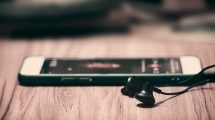Headphone listeners think they’re hard of hearing: new study indicates that up to 41 per cent of Australians may believe they have some form of hearing loss
18 December 2017
- Up to 41 per cent of a cohort of 4185 study participants felt they had a hearing loss
- Headphone listeners need to ask three simple questions: How loud, how long, and how often do you listen?
- The researchers advise to keep sound levels below 80 per cent of full volume, and limit listening time to no more than 1.5 hours per day
A new study, which assessed the impact of personal listening devices (PLDs) on the hearing of a group of 4185 Australians, has indicated that up to 41 per cent of users may feel that they have a hearing loss. The research, led by experts at National Acoustic Laboratories within Macquarie University’s Australian Hearing Hub, breaks down how Australians could be inducing hearing loss through their use of smartphones and MP3 players.
“We found that 41 per cent of participants reported feeling they have a hearing loss, with 20 per cent reporting difficulties with speech in noise. For 18- to 35-year-olds, higher-risk status was associated with a greater proportion of these self-reported hearing difficulties, including perceived poorer speech perception,” explained lead author Dr Megan Gilliver from National Acoustic Laboratories, a Core Member of the HEARing CRC, at Macquarie University.
In terms of hours spent listening to PLDs, the researchers found that the youngest age group of 15 to 19 year olds listened to PLDs for an average of around 88 hours a month. Older age groups incrementally decreased in the average amount of time they reported using PLDs, with the over 50s listening to a personal device for an average of only 47 hours a month.
“Interestingly, reported average listening volume stayed fairly similar across age groups at around 48-55 per cent of the maximum volume of a device. However, within the age groups, particularly the younger ones, we were able to determine certain groups that were at greater risk of hearing loss due to opting to listen to high volumes for longer durations,” said Dr Gilliver.
The study finds that the types of PLDs Australians prefer listening to include MP3 devices, computers, and phones which made up a combined 88 per cent of total listening duration across the group.
“More than a quarter of participants’ overall listening time was undertaken using the default earbuds or headphones that came with their device. Only a small percentage of listening time, around 7.5 per cent, was undertaken with noise-cancelling devices, meaning that only a small number of us are taking advantage of newer technology that cuts out background sound and can really help with reducing overall exposure,” said co-author Dr Elizabeth Beach, also from National Acoustic Laboratories at Macquarie University.
The results, the authors say, indicate that while most Australians are listening responsibly, there are many who need to either drop the volume a little or listen for a shorter duration to reduce the risk of experiencing hearing difficulties.
“High-risk users, who listened at high volumes for long durations, in all age groups were more likely to report hearing difficulties, particularly in relation to speech and conversation, compared with those with lower levels of risk. These results suggest a potential relationship between PLD use and speech-in-noise hearing difficulties, indicating that PLD users need to be aware that their listening habits could be impacting their ability to hear in other settings,” said Dr Gilliver.
The research team also emphasised that there are some simple tips that PLD users can follow to help manage their risk, which include being mindful of your volume level and limiting listening time.
“It’s really boils down to three simple questions: How loud, how long, and how often do you listen? Our advice is to keep it below 80 per cent of full volume, and limit your listening time to no more than 1.5 hours per day. If you’re a regular listener, it’s a good idea to invest in a pair of good quality, well-fitting, noise-cancelling earbuds or headphones. Not only will you appreciate the sound quality, you’ll find you won’t need to use your volume control to drown out unwanted background sounds,” concluded Dr Beach.
Gilliver, Megan; Nguyen, Jenny; Beach, Elizabeth F; Barr, Caitlin. Personal Listening Devices in Australia: Patterns of Use and Levels of Risk. Seminars in Hearing. November 2017.
Filed under: Featured Health & medicine Research

